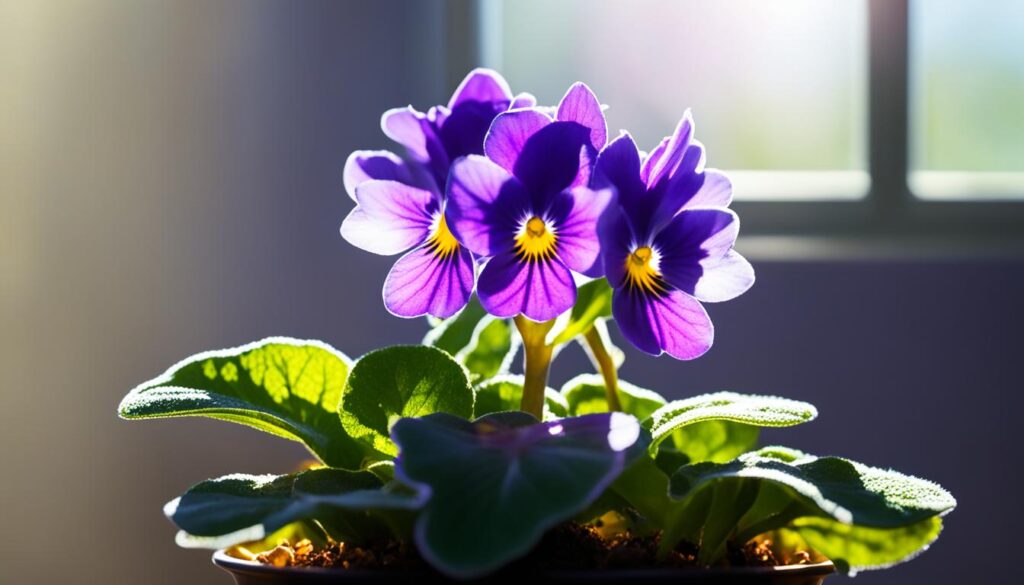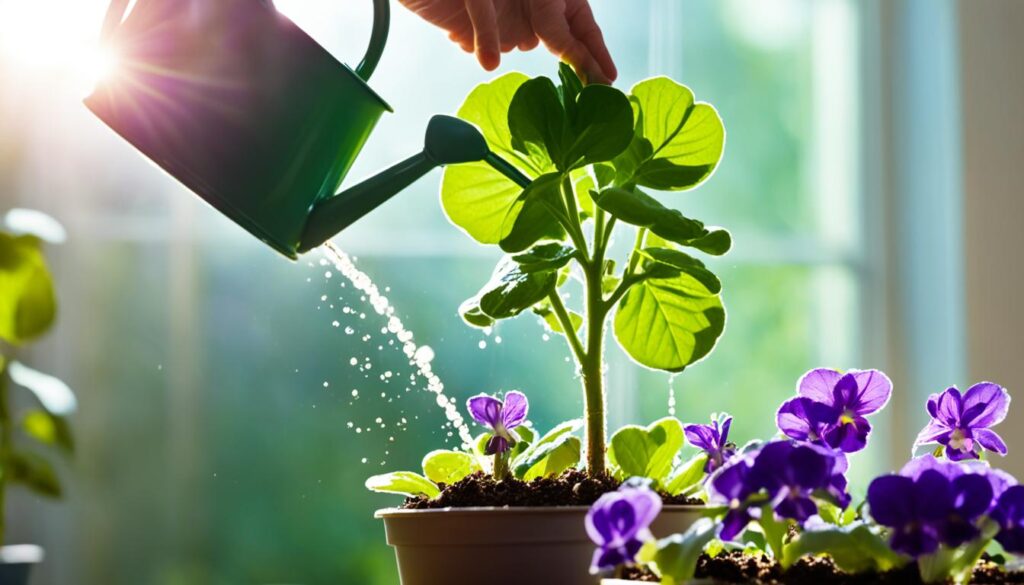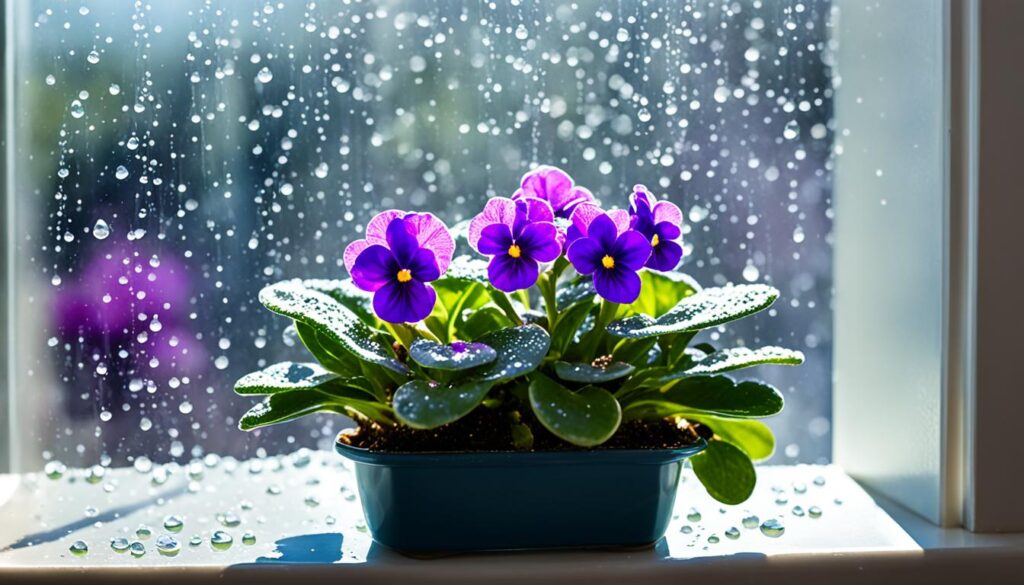African violets are a popular choice for indoor flowering plants, known for their compact, prolific foliage and vibrant blooms that can last for weeks. Also called Saintpaulia, these plants were first discovered in 1892 by Baron Walter von Saint Paul in Tanzania. African violets belong to the Gesneriaceae family, which includes other popular flowering plants like Streptocarpus and Gloxinia. Thanks to their widespread popularity, African violets now come in a variety of colors, flower shapes, and sizes, including standard and miniature varieties. However, these how to care for an african violet plants require specific care to thrive indoors and maintain their long-lasting blooms. This article will provide expert tips on the key aspects of african violet care tips, including lighting, watering, temperature, humidity, potting, fertilizing, propagation, and troubleshooting common problems.
Key Takeaways
- African violets prefer a temperature range of 65°F to 80°F and high humidity levels around 80%.
- Bright, indirect light is essential for African violets, with 10-12 hours of daily exposure.
- Watering techniques like bottom watering and wicking systems help prevent crown rot.
- A well-draining soil mix of peat, perlite, and vermiculite is recommended for optimal growth.
- Regular fertilization with a balanced liquid fertilizer ensures continued blooming.
Origins and History of African Violets
In 1892, Baron Walter von Saint Paul discovered the African violet, Saintpaulia ionantha, in the East African country of Tanzania. The genus Saintpaulia was named after this explorer, while the specific epithet ionantha refers to the violet color of the flowers. African violets belong to the Gesneriaceae family, which also includes popular flowering plants such as Streptocarpus and Gloxinia.
Saintpaulia Genus and Gesneriaceae Family
Over time, the original African violet plant has been extensively hybridized, resulting in a wide range of flower colors, shapes, and sizes. It is now common to see pink, white, mauve, and bicolor blooms, as well as single and double blossom varieties. Standard African violet plants typically grow 8-12 inches in size, while new miniature varieties stay around 4 inches in width.
Hybridization and Varieties
The Saintpaulia genus of African Violets was discovered by Baron Walter von Saint Paul-Illaire in 1892. Botanical experts currently classify the Saintpaulia into six major species, with the smallest among them being the Saintpaulia pusilla, known to be extinct in the wild. The discovery of the African violets in Udzungwa National Park in Tanzania, where the plants originate, raised interest and concern about the conservation of the rare and possibly extinct Saintpaulia pusilla species.
Light Requirements for African Violets
African violets prefer bright, indirect light and perform best with 10-12 hours of light per day. In their natural habitat, these plants are protected by the canopy of forest trees, receiving filtered sunlight. During the brighter summer months, they may benefit from some direct sunlight, but direct light can damage the foliage. In the winter when sunlight is weaker, plants may thrive better with light from a southern exposure.
Natural Light Needs
African violets require a healthy dose of indirect sunlight for photosynthesis and overall health. It is recommended that they receive 8-9 hours of darkness daily for optimal blooming. Rotating African violets every few weeks ensures equal distribution of light for balanced growth.
Artificial Light Options
Many experts recommend using artificial lighting as a reliable alternative to natural sunlight. The best setup is a pair of 40-watt fluorescent lights, with one being cool-white and the other warm-white daylight, placed 8-12 inches above the plants. When grown under artificial light, African violets should receive around 600 foot-candles of light for about 16 hours per day using fluorescent lamps. If an African violet has dark, healthy leaves but no blooms, it may need more light, while pale leaves indicate the plant is receiving too much light.

Temperature and Humidity Preferences
African violets are well-suited for indoor environments and prefer a temperature range between 65°F and 80°F. These plants thrive in high humidity, ideally between 60-80%. To provide the necessary african violet humidity needs, growers can use a humidifier or place pots on a tray filled with gravel and water, making sure the pot is not sitting directly in the water. It is important to avoid sudden temperature and humidity fluctuations, as well as drafts, which can be detrimental to the plants. Misting the foliage is not recommended, as it can cause permanent leaf spotting.
Ideal Temperature Range
In their natural habitat, African violets prefer an ideal temperature for african violets between 65°F and 80°F. This african violet temperature requirements range allows them to thrive and maintain their vibrant blooms.
Maintaining High Humidity
To maintain humidity for african violets, growers can utilize various techniques. Using a humidifier or placing pots on a tray filled with gravel and water can help boost the moisture levels around the plants. Monitoring humidity levels accurately with a hygrometer is also recommended to ensure the african violet humidity needs are met. Distilled water should be used in humidifiers to prevent mineral buildup on the plant leaves. Additionally, grouping African violets together can create a shared microclimate that increases the overall humidity.
Watering Techniques for African Violets
African violets are susceptible to crown rot, so it is important to avoid getting water on the plant’s crown, which is the section at the soil level. The best watering method is to bottom water the plants by placing the pot in a saucer filled with room-temperature water for 15-30 minutes, allowing the soil to absorb the moisture through the drainage hole.
Bottom Watering Method
Another effective technique is the wicking system, where a synthetic cord is buried in the soil and extends through the drainage hole into a water-filled saucer. This allows the soil to wick up water as needed.
Wicking System
Self-watering pots, which consist of an outer glazed pot and an inner porous pot, can also be used to provide a constant water source for the african violet plants.
Self-Watering Pots
By using these various watering methods, growers can ensure their african violet plants receive the right amount of moisture without risking crown rot or other water-related issues.

Potting and Soil Mix for African Violets
Proper potting and soil selection are crucial for the long-term health and vitality of African violet plants. Repotting these delicate flowers every 6 months is typically ideal to provide fresh nutrients and remove any salt buildup in the soil. The diameter of the new container should be no more than one-third the width of the plant’s leaf span, as African violets prefer a slightly rootbound condition.
Ideal Soil Mixture
The recommended African violet potting mix is a light, well-draining blend of equal parts peat moss, perlite, and vermiculite. This combination allows for excellent drainage while still retaining sufficient moisture for the plant’s needs. Many commercial potting mixes may require the addition of dolomite lime to achieve the optimal pH range of 6.0 to 7.0, which is ideal for African violets.
pH Balance
Maintaining the proper pH balance is crucial for the health and longevity of African violet plants. Most African violet experts recommend a slightly acidic to neutral soil pH range of 6.0 to 7.0. Growers can opt for a pre-made African violet potting mix or amend a general potting soil with dolomite lime to reach the ideal pH level.
Fertilizing African Violets
African violets benefit from regular fertilization to maintain healthy growth and prolonged blooming. Growers should apply a liquid fertilizer diluted to half or one-quarter strength every time the plant is watered. This helps prevent damage to the delicate roots.
Liquid Fertilizer Solution
The ideal fertilizer formulation for african violet fertilizer is one with a balanced NPK ratio, such as 20-20-20. Specialty african violet liquid fertilizer products are also available at garden centers. It is important not to overfertilize, as this can lead to salt buildup and damage the plants.
Balanced NPK Ratio
A balanced fertilizer for african violets with the right NPK ratio is crucial for bloom success. African violets should be fed every 4 to 6 weeks during their active growth periods to encourage vibrant, how to fertilize african violets and maintain their lush foliage and long-lasting flowers.

Additional Care Tips for African Violets
While African violets are generally easy-to-care-for houseplants, there are a few additional tips and considerations to keep in mind to ensure their long-term health and vibrant blooms. One important factor is preventing salt buildup in the soil, which can lead to leaf and stem damage.
Preventing Salt Buildup
Over time, fertilizer salts can accumulate in clay pots, coming into direct contact with the African violet leaves and stems. This can cause burning, rotting, and overall decline of the plant. To avoid this issue, it is best to avoid overfertilizing and consider using waterproof pot barriers or opting for glazed ceramic or plastic pots instead of unglazed clay.
Pest Control
African violets can also be susceptible to common pests like mealybugs, aphids, and spider mites. Signs of an infestation may include white cottony secretions, stunted or distorted new growth, and an overall decline in plant health. If pests are detected, growers should contact their local university extension office or garden center for appropriate treatment recommendations to control the issue and prevent further damage to their African violet plants.

how to care for an african violet
To provide optimal care for an African violet, growers should focus on several key aspects.
Deadheading for Prolonged Blooming
Deadheading, or removing spent blooms, is an important step to prolong the flowering cycle and encourage a second flush of flowers.
Optimal Lighting Conditions
African violets require bright, indirect light for 10-12 hours per day, which can be provided by natural sunlight or artificial lighting.
Watering Techniques
Careful watering techniques, such as bottom watering or using a wicking system, are crucial to avoid crown rot and leaf spotting.
Humidity and Temperature
Maintaining high humidity levels between 60-80% and keeping the plants in a temperature range of 65-80°F are also essential for healthy growth and prolonged blooming.

Propagating African Violets
African violets can be easily propagated to create new plants. The most common method is through african violet leaf cuttings. Growers can take a fully grown leaf with a short stalk (petiole) and plant it in a wet sand/vermiculite mixture, covering it lightly with plastic to maintain moisture. Within 2-6 months, new plantlets will form on the leaf, which can then be carefully separated and potted individually.
Separating Suckers
Another propagation technique is to divide the clumps of rosettes from the main african violet plant and pot them up in fresh soil to establish new plants. This process of separating african violet suckers allows growers to multiply their collection and share the joy of propagating african violets with friends and family.

Common Problems and Solutions
Despite their reputation as relatively easy-to-grow houseplants, African violets can sometimes encounter issues that affect their growth and blooming. One common problem is a lack of blooms, which can be caused by insufficient light levels. To promote flowering, African violets require 10-12 hours of bright, indirect light daily. Another issue is leaf discoloration, which can be a sign of various problems such as overwatering, disease, or pest infestations. Growers should closely monitor their African violets and make adjustments to factors like lighting, watering, and humidity to address any problems that arise and keep their plants thriving.
Lack of Blooming
If an African violet is not producing the expected number of blooms, it could be due to a lack of suitable lighting. These plants require 10-12 hours of bright, indirect light per day to stimulate and maintain flowering. Growers should ensure their African violets are receiving the appropriate amount of light, either from natural sunlight or artificial sources, to promote continuous blooming.
Leaf Discoloration
Leaf discoloration, such as yellowing, browning, or spotting, can indicate various issues with an African violet. This could be a sign of overwatering, disease, or pest infestations. Growers should closely inspect the plant, adjust watering practices, and monitor for any signs of pests or other problems. Addressing the underlying cause of the leaf discoloration is crucial to keeping the African violet healthy and thriving.

Choosing the Right Variety
African violets come in a wide range of african violet varieties, from the classic standard-sized plants to newer miniature cultivars. Standard African violet varieties typically grow 8-12 inches in size, while miniature african violet varieties stay around 4 inches in width. Both standard and miniature varieties offer a diverse selection of flower colors, shapes, and growth habits to suit different preferences and home environments.
Standard Varieties
The standard african violet varieties are the classic choice for many growers, with their larger, lush foliage and abundant blooms. These plants can thrive in a variety of lighting conditions and add a striking visual presence to any indoor space.
Miniature Varieties
For those with limited space or seeking a more compact option, miniature african violet varieties are an excellent choice. These diminutive plants maintain the same vibrant colors and charming blooms as their standard counterparts, but in a more manageable size that can fit on a windowsill or side table.
When choosing african violet plants, growers should consider the available space, their lighting conditions, and the specific features they desire, such as flower color or plant size, to select the most suitable variety for their needs.
Conclusion
African violets are a beloved indoor flowering plant that can add vibrant color and long-lasting blooms to any home. By understanding the specific care requirements for these plants, including their light, watering, humidity, temperature, and fertilization needs, growers can ensure their African violets thrive and continue to produce an abundance of beautiful flowers throughout the year. With the right growing conditions and a little attention, these versatile plants can be a rewarding addition to any houseplant collection.
The statistical data provided offers valuable insights into the web page configuration, user interface elements, and event handling related to the topic of caring for African violets. Factors such as cart counts, viewport widths, cache management, and device identification are analyzed to optimize the overall user experience and ensure the content is easily accessible and engaging for readers.
By following the expert tips and recommendations outlined in this article, gardeners can unlock the full potential of their African violets and enjoy the vibrant blooms and lush foliage that make these plants a cherished addition to any indoor space. With the right care and attention, African violets can flourish and bring a touch of natural beauty to any home.


